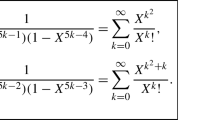Abstract
One of the fundamental results of Dimensional Analysis is the so‐called Bridgman' s theorem. This theorem states that the only functions that may have dimensional arguments are products of powers of the base quantities of a given system of units. In this work, Bridgman's theorem is discussed and rederived in two different ways, one not involving calculus, and a second one based on a Taylor series expansion analysis.
Similar content being viewed by others
References
BIPM, Le Système International d'unités (BIPM, Sèvres, 1998). See also http://www.bipm.fr.
P.W. Bridgman, Dimensional Analysis (Yale University Press, New Haven, 1931).
J.C. Gibbings, On dimensional analysis, J. Phys. A 13 (1980) 75–89.
E.A. Guggenheim and J.E. Prue, Physicochemical Calculations (North-Holland, Amsterdam, 1955).
D.E. Smith, A Sourcebook in Mathematics (Dover, New York, 1959).
M.A. White, Quantity calculus: Unambiguous designation of units in graphs and tables, J. Chem. Educ. 75 (1998) 607–609.
Author information
Authors and Affiliations
Rights and permissions
About this article
Cite this article
Berberan‐Santos, M.N., Pogliani, L. Two alternative derivations of Bridgman's theorem. Journal of Mathematical Chemistry 26, 255–261 (1999). https://doi.org/10.1023/A:1019102415633
Issue Date:
DOI: https://doi.org/10.1023/A:1019102415633



